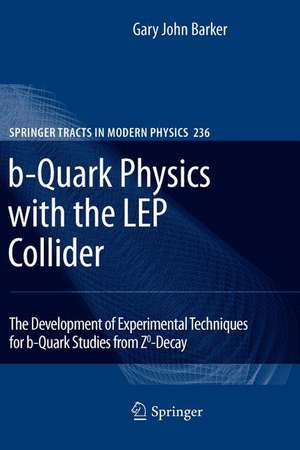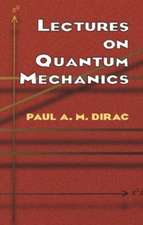b-Quark Physics with the LEP Collider: The Development of Experimental Techniques for b-Quark Studies from Z^0-Decay: Springer Tracts in Modern Physics, cartea 236
Autor Gary John Barkeren Limba Engleză Paperback – 28 iun 2012
| Toate formatele și edițiile | Preț | Express |
|---|---|---|
| Paperback (1) | 551.32 lei 39-44 zile | |
| Springer Berlin, Heidelberg – 28 iun 2012 | 551.32 lei 39-44 zile | |
| Hardback (1) | 641.03 lei 6-8 săpt. | |
| Springer Berlin, Heidelberg – 29 mai 2010 | 641.03 lei 6-8 săpt. |
Din seria Springer Tracts in Modern Physics
- 15%
 Preț: 648.42 lei
Preț: 648.42 lei - 18%
 Preț: 887.38 lei
Preț: 887.38 lei - 18%
 Preț: 1127.60 lei
Preț: 1127.60 lei - 20%
 Preț: 814.70 lei
Preț: 814.70 lei - 20%
 Preț: 816.04 lei
Preț: 816.04 lei - 18%
 Preț: 1424.83 lei
Preț: 1424.83 lei - 18%
 Preț: 785.55 lei
Preț: 785.55 lei -
 Preț: 409.63 lei
Preț: 409.63 lei -
 Preț: 428.30 lei
Preț: 428.30 lei -
 Preț: 426.34 lei
Preț: 426.34 lei -
 Preț: 387.38 lei
Preț: 387.38 lei -
 Preț: 387.20 lei
Preț: 387.20 lei -
 Preț: 381.21 lei
Preț: 381.21 lei -
 Preț: 378.71 lei
Preț: 378.71 lei -
 Preț: 382.95 lei
Preț: 382.95 lei -
 Preț: 384.48 lei
Preț: 384.48 lei -
 Preț: 382.36 lei
Preț: 382.36 lei -
 Preț: 387.38 lei
Preț: 387.38 lei -
 Preț: 391.40 lei
Preț: 391.40 lei -
 Preț: 380.63 lei
Preț: 380.63 lei -
 Preț: 386.00 lei
Preț: 386.00 lei - 18%
 Preț: 884.07 lei
Preț: 884.07 lei -
 Preț: 386.00 lei
Preț: 386.00 lei -
 Preț: 385.25 lei
Preț: 385.25 lei -
 Preț: 383.71 lei
Preț: 383.71 lei -
 Preț: 377.95 lei
Preț: 377.95 lei -
 Preț: 377.18 lei
Preț: 377.18 lei -
 Preț: 377.95 lei
Preț: 377.95 lei -
 Preț: 384.70 lei
Preț: 384.70 lei -
 Preț: 381.98 lei
Preț: 381.98 lei -
 Preț: 391.61 lei
Preț: 391.61 lei -
 Preț: 379.68 lei
Preț: 379.68 lei -
 Preț: 384.70 lei
Preț: 384.70 lei -
 Preț: 391.40 lei
Preț: 391.40 lei -
 Preț: 378.92 lei
Preț: 378.92 lei -
 Preț: 380.25 lei
Preț: 380.25 lei -
 Preț: 377.35 lei
Preț: 377.35 lei -
 Preț: 382.57 lei
Preț: 382.57 lei -
 Preț: 384.31 lei
Preț: 384.31 lei -
 Preț: 381.21 lei
Preț: 381.21 lei -
 Preț: 387.96 lei
Preț: 387.96 lei -
 Preț: 381.43 lei
Preț: 381.43 lei -
 Preț: 384.48 lei
Preț: 384.48 lei -
 Preț: 386.22 lei
Preț: 386.22 lei - 18%
 Preț: 1224.99 lei
Preț: 1224.99 lei
Preț: 551.32 lei
Preț vechi: 689.16 lei
-20% Nou
Puncte Express: 827
Preț estimativ în valută:
105.50€ • 112.81$ • 87.96£
105.50€ • 112.81$ • 87.96£
Carte tipărită la comandă
Livrare economică 14-19 aprilie
Preluare comenzi: 021 569.72.76
Specificații
ISBN-13: 9783642263507
ISBN-10: 364226350X
Pagini: 184
Ilustrații: XI, 200 p. 92 illus.
Dimensiuni: 155 x 235 x 10 mm
Greutate: 0.27 kg
Ediția:2010
Editura: Springer Berlin, Heidelberg
Colecția Springer
Seria Springer Tracts in Modern Physics
Locul publicării:Berlin, Heidelberg, Germany
ISBN-10: 364226350X
Pagini: 184
Ilustrații: XI, 200 p. 92 illus.
Dimensiuni: 155 x 235 x 10 mm
Greutate: 0.27 kg
Ediția:2010
Editura: Springer Berlin, Heidelberg
Colecția Springer
Seria Springer Tracts in Modern Physics
Locul publicării:Berlin, Heidelberg, Germany
Public țintă
ResearchCuprins
b-physics at LEP.- Silicon Vertex Detectors and Particle Identification.- Experience in Reconstructing Z0 ? b?b Events.- Tagging Z0 ? b?b Events.- Tagging b-quark Charge.- Double-Hemisphere Tagging.- Optimal b-Flavour and b-Hadron Reconstruction.- Conclusion and Next Steps.
Textul de pe ultima copertă
The book reviews the unexpected impact that the LEP experiments have had on the subject of b-quark physics. The emphasis is firmly on telling the story from an experimental viewpoint. Aspects of the detectors that were essential for the reconstruction of b-hadrons are highlighted, especially the role played by silicon strip detectors and particle identification methods. The importance of solving practical issues such as detector alignment and track reconstruction to fully realize the reconstruction potential of the detectors is demonstrated along with various examples of potential problems when these aspects are not well controlled. Barker details new ideas and analysis techniques that evolved during the years of LEP running so that the information is useful to new researchers or those putting together plans for future b-physics experiments. Highlights of the final b-physics results from the LEP collaborations are reviewed in the context of results from other experiments around the world and with respect to what we learn about the Standard Model of Particle Physics.
Caracteristici
Comprehensive description of experimental methods Includes supplementary material: sn.pub/extras















